OCZ Suite Tour: Vector 180, JetExpress PCIe NVMe Controller & Z-Drive 6000
by Kristian Vättö on January 9, 2015 8:08 PM EST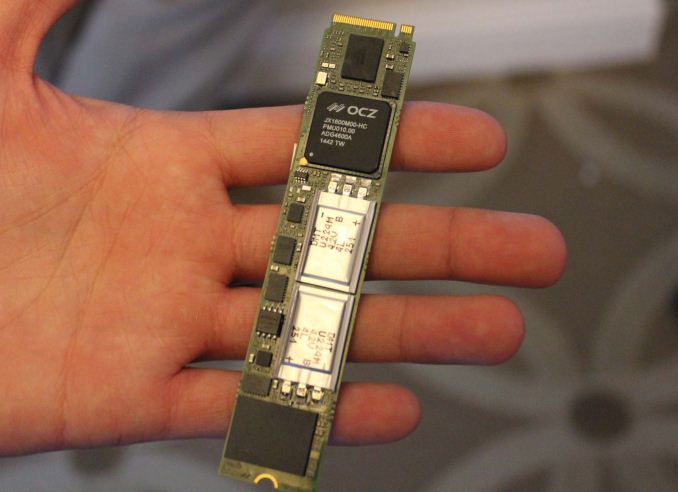
While the Barefoot 3 platform is already a couple of years old, it is still going strong. OCZ has been in the process of adopting Toshiba's latest A19nm to its whole product lineup and with all other drives having made the change, the Vector is the last (but definitely not the least) to make the switch to the latest NAND process.
Aside from the new NAND, OCZ is also adding a new 960GB capacity. We have seen many OEMs upping their capacities to 960GB/1TB in the past six months or so and the Vector 180 marks as OCZ's first client-level SATA SSD with 1TB-class capacity. The Vector 180 also features partial power-loss protection (or Power Failure Management Plus as OCZ calls it), which is not a full implementation like in enterprise drives, but there are capacitors to ensure that data at rest is safe. In other words, all user data in the DRAM buffer will still be lost in the case of sudden power loss, but the capacitors ensure that all metadata is safe and that the drive will continue to operate normally after a power loss (i.e. the NAND mapping table won't be lost, which can brick the drive or at least slow down the next boot up as the drive has to go through recovery process).
The rest of the specs remain pretty much unchanged from the Vector 150. The drive is rated at 50GB of writes per day and carries a 5-year ShieldPlus warranty (no purchase receipt required and all defective drives will be replaced with brand new units). Given that the controller and the underlying firmware remain unchaged I would expect the performance to be very similar to the Vector 150.
Unfortunately, the Barefoot 3 platform still doesn't support low-power states, so the main market for the Vector 180 will be in desktop systems. This is a problem in the silicon itself (it is two years old, after all) and to fix that the silicon would require a redesign, so instead of spending resources on that OCZ has decided to focus on the next generation JetExpress controller.
Originally OCZ's plan was to release the Vector 180 here at CES, but the company decided to spend a bit more time validating the drive to ensure that everything is okay (which, as some of you may remember, is quite different from what OCZ used to do a few years ago). Availability should be in the coming weeks, though, and I would expect pricing to be close to the Vector 150 or perhaps a bit lower given the new, more cost efficient NAND.
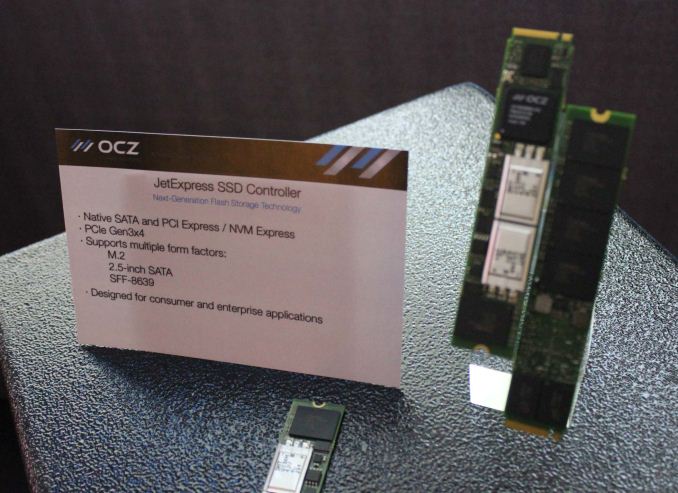
The big and obviously interesting news is OCZ's JetExpress controller. It's a native PCIe 3.0 x4 controller with NVMe support and SATA/AHCI are also included for legacy support (SATA isn't going anywhere anytime soon anyway). In terms of features the JetExpress has pretty much all the bells and whistles. DevSleep, TCG Opal 2.0, eDrive, LDPC error correction and TLC NAND are all supported. The controller itself is small enough to fit in M.2 as seen above, unlike the FPGA designs that we have seen in drives like the Samsung XS1715.
Architecturally the JetExpress sports the same Aragon cores as the Barefoot 3, but the core count is much higher (I'm hearing seven cores) with each core having its own specific purpose. The chip consists of several power islands, which can be shut down individually for increased power efficiency. The DRAM controller is massive and supports up to 32GB of DDR3, which enables very high capacities (I was told that even 10TB is achievable, although in most cases the problem is the form factor and its physical limitations, not the controller itself).
OCZ will start by shipping the JetExpress to enterprise customers in the first half of 2015 and a client release will follow in H2'15 -- most likely right around the time Intel releases its Skylake platform with proper PCIe and NVMe support.
OCZ's ECC engine is also quite interesting. The controller supports both BCH and LDPC error correction and there are three different modes (high performance, high endurance and hybrid) available. Basically, high performance mode means that only BCH ECC is used, which has less overhead than LDPC but isn't as powerful and thus results in lower endurance. The high endurance mode, on the other hand, has LDPC enabled, which increases the endurance by about 3x from what I've heard. The hybrid mode basically has BCH enabled at first, but as the NAND is cycled and starts to require more ECC, LDPC will kick in to boost the endurance. The reason why OCZ is offering all three modes is that LDPC adds some latency, so once it kicks in there is some performance loss and typically enterprise customers want a device that has predictable performance throughout its life (or at least an option to choose a mode like that). Similarly, some customers value performance more than endurance (online transaction processing is a good example since the more transactions you can do the more money you will make), so OCZ is offering the customer the opportunity to select what mode is the best for their usage.
In addition to the upcoming JetExpress drive OCZ was showing off their upcoming Z-Drive 6000 for enterprises with NVMe support. The drive comes in 2.5" 15mm form factor with the SFF-8639 connector (basically the enterprise version of SATA Express) and utilizes PCIe 3.0 x4 interface. The Z-Drive features the same PMC controller as Samsung's XS1715 but obviously the firmware is à la OCZ. Performance comes in at up to 3GB/s for sequential reads and 2GB/s for writes and random performance is up to 700K IOPS for reads and 175K for writes. Capacities go all the way up to 3.2TB, although OCZ was very confident that the company can build a 6.4TB version as well. OCZ is currently sampling a handful of key OEMs and volume availability should be in the coming months.
I spent a good hour talking with OCZ's CEO, Ralph Schmitt, about how OCZ is doing under Toshiba and what is the direction of the company, so watch out for a deeper dive after CES.


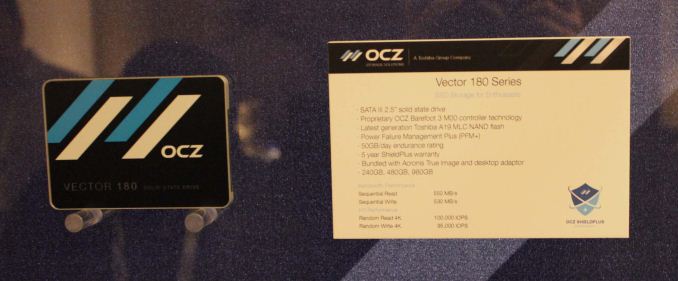
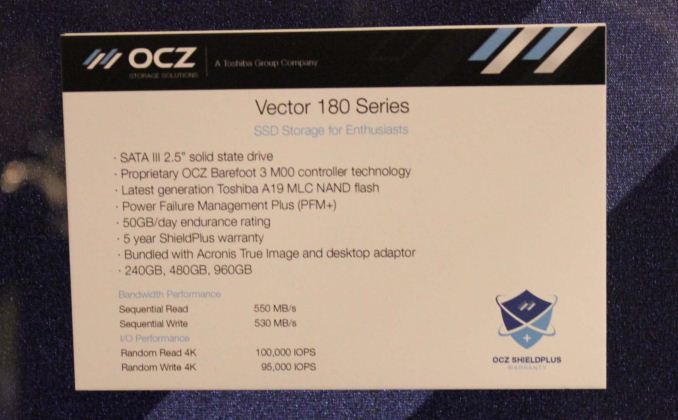
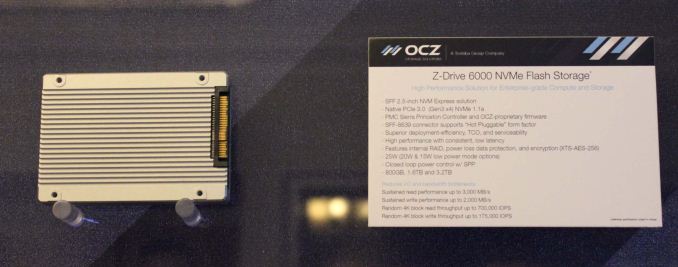








26 Comments
View All Comments
hosps - Friday, January 9, 2015 - link
And yet another version of the same drive. This now make #6 (not including Vector and Vertex 450) and the only difference is in the warranty and handicapping the firmware. Please stop the madness and get 1-2 product lines which make sense. At least they are finally up front about Barefoot not supporting low-power states which is probably why their drives were constantly failing in the first place. Too bad so many consumers had to pay the price losing their data. The only positive out of all of this is now when their drives fail, you get a new drive and don't have to hold onto the receipt. Shows they have more confidence in their RMA process than their controller.Samus - Saturday, January 10, 2015 - link
I don't know about your experience, but it doesn't mirror most other end users'.Barefoot 3 has staggeringly low failure rates. It's a clean, consistent controller and the quality of Toshiba NAND is much better than the often second-off NAND they were being supplied by random suppliers during the Sandforce-era.
hosps - Saturday, January 10, 2015 - link
What is your definition of staggeringly low? It has been well documented that OCZ has significantly higher return rates (7%+ vs <1% from many of their competitors). Toshiba may be providing better flash than in the past but OCZ has yet to prove they have a reliable product compared to their competition. The fact they finally admit the Barefoot design can't handle low power states and requires a respin of the chip should be a dead giveaway to stay clear.ocztosh - Saturday, January 10, 2015 - link
Hello hosps, samus,As this is my first comment in regards to this article please allow me to identify myself as a member of OCZ Storage Solutions. Thank you both very much for your comments and we appreciate all input.
In regards to reliability there were indeed some products from the previous organization which used third party controllers and exhibited issues, and the fixes often took a long time due to inability to control the firmware source. There were also some problem products like those in the Octane and Petrol Series that over time exhibited a 6.4% return rate nearly 3 years ago. Much too high, and certainly not acceptable. A lot of this was the driving motivation for the organization, even prior to becoming part of Toshiba, to make great investments in new processes from design through manufacturing, as well solidifying the need to vertically integrate to control everything from the asic through the firmware.
In comparison Barefoot 3 has very low return rates, and extremely low actual failure rates. Over time the failure rates are well below 1% (.1% in some skus) on products like the Vector 150 for example. It is a fact that the Barefoot silicon has never been reved, which is a testament to the controller. Also as part of the Toshiba Group we also are able to lock down the flash we use, all of which is premium SSD grade NAND. This complete access to Toshiba NAND has allowed us to take the controller further than we have in the past while improving reliability at the same time.
We completely understand the quality concerns from the past and appreciate your comments. We have changed everything from the people to the design process, and even the manufacturing and validation, even transitioning to building all our drives at a Toshiba certified partner factory, and are continually investing in this area as it is a key priority for us. Thank you again for the comments and dialogue.
mapesdhs - Saturday, January 10, 2015 - link
hosps comment is typical of the FUD that followed after the problems with certain SF-basedunits way back. People just assumed the later models were similarly affected, but that was
never the case. The Vertex4 and Vector were excellent SSDs, I have many.
Ian.
TheTom - Saturday, January 10, 2015 - link
Indeed - while, anecdotally, I've had to return an OCZ Vector (twice) due to the "panic lock" issue (2nd RMA works fine - if they would have given me a tool to unlock it I could have done it myself ;) ), I also have two Agility 3, a Vertex 2, an Agility 2 and now two Vertex 460s that have given me zero problems. Some (most) of those are old drives in the SandForce "problem" era too. While I'd previously only recommend them to users that can stay on top of firmware updates, with their new advance RMA return policy I'd have no issues trying more drives from OCZ. The Vertex 460 drives were plug-and-play, and have been a good experience so far for me.mapesdhs - Monday, January 12, 2015 - link
And for the older SF models, once the firmware is updated, they run just fine. I haveabout 30 of them, no problems at all. One is running in an SGI with no issues either
(120GB 3.5" V2E, soon to be upgraded though as it's almost full), so even under an
'alien' OS, they fare very well. Indeed, one reason whyI chose the V2E is tests
showed it performed better than most with OS types that lacked TRIM, which of
course includes XP, but in my case it was IRIX. OCZ models also consistenly
select the correct speed when connected to SAS controllers in UNIX systems
(Samsung SSDs don't, one must use a specific firmware for some SAS cards).
I've also obtained an Agility 4, a dozen MAX IOPS units (UNIX RAID0 testing for Flame),
numerous 60GB/120GB V2Es for general benchmarking/testing (multiple CPU/mbd/gfx
combos), some Vectors, a Vector 150 and a number of Vertex4s which I really like.
The only down side of modern OCZ units is price. It's hard to ignore the value of models
like the X300. However, I'll continue hunting for used OCZs, especially V4s and Vectors.
Ian.
zodiacsoulmate - Saturday, February 14, 2015 - link
my vertex4 and vertex 460 are working consistently, but my vector died 3 times, my vector 150 just died and I'm going to RMA it again ...vector is performance monster but
Kristian Vättö - Saturday, January 10, 2015 - link
Low-power states have absolutely nothing to do with reliability. The only downside is higher power consumption, which is why Barefoot 3 isn't really suitable for laptops.ocztosh - Saturday, January 10, 2015 - link
Thank you Kristian, you are absolutely correct. The Barefoot 3 controller was originally designed for enthusiast drives and sustained performance was a priority. It was never designed for low power (i.e. DevSleep). As you mentioned this doesn’t have an impact on reliability but agree that it may not be appropriate for some applications that require sleep modes.